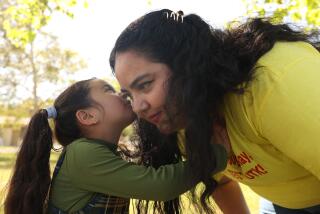UCLA Program Nurtures Literacy Through Turtle Talk
- Share via
The two turtles in the center of the classroom--placidly munching lettuce on a plastic lunch tray--do not immediately appear to have anything to do with teaching literacy skills to the noisy 4-year-olds who surround them.
But from the book-lined reading corner in the back of the room to the turtle tray in the front, teachers and administrators at UCLA’s Corinne A. Seeds University Elementary School view almost every preschool activity as a way to nurture literacy.
In a colorful classroom at the woodsy north end of UCLA’s campus, some of the 22 students in teacher Hazmik Avetisian’s preschool class are parked on the floor, creating “stories” on large sheets of butcher paper. Some draw figures first, and Avetisian will help them add words later. With a more advanced student, Avetisian may use an illustrated dictionary to point out words in the child’s story.
Others are working with a teacher’s aide on their “feeling books,” in which they try to spell out the words that tell how they are feeling that day. Or the aide will write out what the children explain to her about their feelings.
“It doesn’t look like most people’s idea of literacy learning, which is teaching them letters and having them say the letters,” Principal Margaret Heritage said during a recent tour of the busy classroom, where students often work and play independently in small groups.
In the reading corner, students can snuggle up with stuffed toys and listen to a teacher read aloud, or they can choose a book themselves.
The whole classroom, Heritage said, is devoted to “sending messages that reading is an enjoyable thing to do.”
UES, as the school is known, enrolls 480 students from kindergarten through sixth grade, and is the laboratory school for the UCLA Graduate School of Education and Information Studies.
Its diverse student body is, in effect, part of educators’ research on early literacy skills.
As for the turtles--Ruby and Tolby--a different student gets to take the pair home every weekend. During that time, parents write down the child’s remarks about the turtles.
The experience shows the children that spoken words can be translated into written words, which can be used to share a story with others. The exercise gives some context to the notion that reading and writing are useful skills.
Because, Heritage notes, “Everybody is interested in what happened to the turtles at everybody else’s house.”
More to Read
Sign up for Essential California
The most important California stories and recommendations in your inbox every morning.
You may occasionally receive promotional content from the Los Angeles Times.













